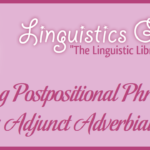The conditional mood in Spanish is a verb form that refers to verbs in the present tense, simple aspect, conditional mood, and active voice. Unlike regular Spanish verbs, the conjugations for irregular verbs in the conditional mood are irregular and unpredictable. However, only a handful of verbs in Spanish are irregular in the conditional mood with most following a pattern. And, to make learning the conditional mood easier for Spanish language students, all Spanish verbs take the same conditional suffixes. The following sections explain the formation of the conditional mood of irregular Spanish verbs.
Irregular Conditional Stems
The first and largest category of irregular Spanish verbs in the conditional mood is the verbs whose stem takes a -dr in place of the infinitive suffix. To form the conditional stem of the –dr verbs, remove the infinitive ending and add a -dr to the end of the verb. (The only exception to this rule is poner “to put” in which the second d is omitted.) For example:
- anteponer “to put in front”: antepondr-
- componer “to compose”: compondr-
- contener “to contain”: contendr-
- detener “to stop”: detendr-
- disponer “to arrange”: dispondr-
- imponer “to impose”: impondr-
- mantener “to maintain”: mantendr-
- obtener “to obtain”: obtendr-
- poder “to be able to”: podr-*
- poner “to put”: pondr-
- proponer “to propose”: propondr-
- reponer “to replace”: repondr-
- retener “to retain”: retendr-
- salir “to leave”: saldr-
- suponer “to suppose”: supondr-
- tener “to have”: tendr-
- valer “to merit”: valdr-
- venir “to come”: vendr-
The second category of irregular Spanish verbs in the conditional mood is the verbs whose stem takes an -r in place of the infinitive suffix. To form the conditional stem of the –r verbs, remove the infinitive ending and add a -r to the end of the verb. For example:
- caber “to fit”: cabr-
- haber “to have”: habr-
- saber “to know”: sabr-
The third category of irregular Spanish verbs in the conditional mood is the verbs whose stems are simply irregular. The verbs in the third category must simply be memorized. For example:
- decir “to say”: dir-
- hacer “to do”: har-
- querer “to want”: querr-
Notice that the irregular conditional stems in Spanish are identical to the irregular simple future stems in Spanish.
Orthographic Changing Conditional Stems
Three common Spanish verbs experience slight a slight spelling change in the conditional mood. For the verbs with orthographic changes, simply remove the accented vowel in the conditional mood. For example:
- oír “to hear”: oir-
- reír “to laugh”: reir-
- sonreír “to smile”: sonreir-
Note that, although the conditional forms of these three verbs are spelled without an accent mark, the accent is still on the same vowel because of the rules for Spanish pronunciation.
Irregular verbs are verbs whose conjugations include a pronunciation or spelling change in the stem of the verb in the conditional mood. Spanish language learners must learn to form the conditional forms of irregular Spanish verbs in order to fully use and understand verbs the Spanish language.
For the conjugations of irregular Spanish verbs in the simple future, please refer to Spanish Conditional: Form and Use of the Conditional Mood of Regular Spanish Verbs.
Note: I have studied Spanish as a foreign language. Please feel free to correct any mistakes that I have made in my Spanish.
References
Ramboz, Ina. 2008. Spanish verbs & essentials of grammar (Verbs and Essentials of Grammar Series), 2nd edn. New York: McGraw-Hill.



